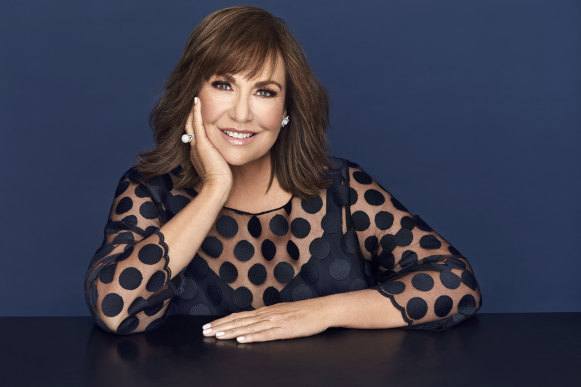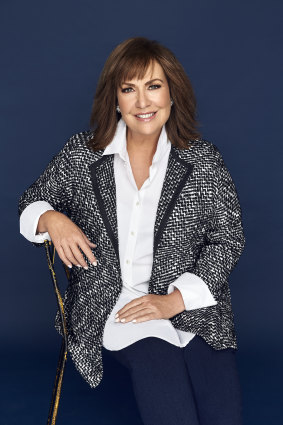This was published 3 years ago
Tracy Grimshaw: 'I get very involved. It's part of my nature'
A few minutes before I call Tracy Grimshaw, an editor suggests – perhaps facetiously – that in this coronavirus era, with popular culture on hiatus and everyone largely confined at home, the new rock stars are in fact newsreaders.
I put the theory to Tracy for a verdict. “That’s weird,” she laughs. “I’m no rock star, trust me. I can’t sing. I seriously have got the worst voice.”

Tracy Grimshaw in clothes by Marina Rinaldi. Jewellery by Gregory Jewellery.Credit: Peter Brew-Bevan
There was certainly no rock star treatment doled out to Tracy in March when she tried to get a test for COVID-19. The virus had morphed from a vague foreign threat to an imminent national crisis. Scott Morrison had closed the borders to inbound tourists. Tom Hanks and Rita Wilson had tested positive. So had Peter Dutton. And so had Richard Wilkins, after meeting Wilson at the Opera House a week earlier.
Over at the Nine Network’s headquarters, Tracy had reason to be nervous. Wilkins had used a dressing room she shares with a few others. Another friend of hers had “close exposure” to both Hanks and Wilson. She felt she was at heightened risk.
“I went off to be tested because I had that level of exposure,” Tracy says. “But NSW Health was being really strict about who could access the testing. They knocked me back.”
Think there’s one rule for some and another for everyone else? Think again.
Tracy turns 60 in June and has been in television for 39 years, the past 14 of them as host of Nine’s A Current Affair. She was only a few months into that role when one of the biggest stories of her career unfolded: the Beaconsfield Mine collapse. Like so many of the country’s journalists, she flew to Tasmania to report from the scene. And she remembers it like it was yesterday. “I was fully engaged and fully immersed and I had no concept of the world outside of Beaconsfield for two weeks,” Tracy says.
But the story we’re currently immersed in dwarfs all of that. As Tracy says, “This is all encompassing.”
Television newsreaders tend to get a bad rap in popular culture. The stereotype perpetuated from Frontline or Anchorman to The Newsroom and Morning Wars tends to range from dim and vacuous to cynical and self-obsessed. It’s always the dogged newspaper reporter, shabbily dressed and married to the job, who exposes injustice and saves the day.
Some might suggest there’s a grain of truth in that but, of course, that’s not the reality. Tracy is a case in point. For one thing, when there’s a big story on, she throws herself into it – whatever the personal toll.
“I tend to go for full immersion, and I get very involved,” she says. “I don’t advocate that, by the way. I think it’s probably just my nature. I tend to be able to empathise fairly well and be able to put myself in people’s positions. Fully immersing yourself in a story if you happen to have that nature is kind of unavoidable.
“If I do an interview with someone who has suffered a terrible loss, I can’t separate myself from their loss. I tend to feel it. I don’t want to overstate that – it’s their loss, not my loss. But I tend to not be able to walk away from it.”
“If I do an interview with someone who has suffered a terrible loss, I can’t separate myself from their loss. I tend to feel it.”
Walking away from it is usually a journalist’s salvation. Once a story is filed, most journalists get to move on to the next one. The pandemic isn’t like that, says Tracy. Normally you work on a harrowing story and then “you have a blow out with your mates, you have a few drinks that night, you go to a restaurant”. You decompress.
“But the opportunities to decompress from this story are very minimal because we can’t see our mates, we can’t go to a restaurant,” she says, referring to restrictions which have since been eased.
“So I feel journalists in this story can’t walk away from it. We keep saying we’re all in it together – we literally are. We are living it as well as reporting it, and in some ways that’s kind of unique.”
That can make the story easier to grapple with, or at least more intuitive. Tracy has the same curiosities as everyone else: What’s next? What will reopen? What will be the timetable? How are we going at suppressing the curve?
“I tend to think that the sorts of questions I wake up each day asking myself are probably the questions most people wake up each day asking themselves,” she says.
Tracy also finds herself tussling with some fundamental principles of journalism. There are competing interests at play: the journalist’s instinct to be sceptical and question authority; the responsibility to communicate what the authorities are saying; the need, perhaps, to rally behind a particular message at a particular time.

Tracy Grimshaw in clothes by Marina Rinaldi. Jewellery by Gregory Jewellery.Credit: Peter Brew-Bevan
“It’s in our DNA to question what we’re told, to wonder about the agenda behind what we’re being told,” says Tracy.
“We ask ourselves: should we be questioning this, do we need to throw our support behind this, what’s the downside to questioning this? You’re constantly tempering your own natural instincts and thinking, ‘We have to be responsible citizens here.’ ”
It’s keeping her up at night. She was spooked by the footage of people lining up outside Centrelink, “people who would never have even known where their local Centrelink office was [before the crisis]”.
She is anxious about people losing patience with the restrictions and the government taking its foot off the brake just as winter hits. The emotional distance journalists often develop from the worlds they cover – desensitisation, perhaps – doesn’t exist for Tracy with this story.
“I can’t detach myself from it,” she says. “I will wake up at 2am and start checking the overseas news websites because I want to know what has happened over there. I want to know everything.”
So does her audience. There has been an insatiable appetite for news about the coronavirus on television, on news websites, on radio, wherever. When the pandemic first exploded, A Current Affair started broadcasting one-hour shows instead of its usual half-hour format and the network started airing late-night news specials which attained ratings usually enjoyed by prime-time bulletins.
“Every media organisation every day is just scrambling to satisfy the hunger for information,” says Tracy, although she notes the interest has inevitably dropped off a little over time.
“While a lot of my friends are at home and baking brownies and drinking too much, I’ve never worked harder in my life. People have lost their jobs and my job’s probably quadrupled.”
Tracy’s job can’t really be done from home, although it wasn’t for lack of trying. She briefly hosted the program from her spare bedroom, sitting at a makeshift desk with a mock studio on a screen behind her.
“Every media organisation every day is just scrambling to satisfy the hunger for information... I’ve never worked harder in my life."
The show went to air successfully but the set-up was logistically “challenging”, Tracy says, and a way was found for her to return to the office while maintaining social distancing – much to the dismay of her dogs. “They had me all day and they thought that was absolutely fantastic. Now I leave them each day and they’re not that happy about that.”
The ACA host is famously private. She doesn’t often engage with the gossip magazines, which are obsessed with female TV personalities. But in early March she reacted to an article which pilloried Tracy’s “diva” attitude, alleging she’d demanded Nine install a secret lift in its new North Sydney building so she can avoid the public.
“Absolute crap,” Tracy wrote on Instagram. “I wouldn’t know anything about the lifts in the new building.”
Tracy’s antipathy was heightened by a story four years ago that accused her of suffering from “crippling shyness” and being “so introverted it actually affects her daily life”. She didn’t challenge the assertion at the time but now wishes she had. With the platform of social media, she doesn’t “have to sit quietly and have a bunch of crap written about me”.
As for the shyness, some years back, Tracy was invited to a friend’s wedding where there was karaoke. Not some voluntary, inebriated singing at the tail end of the reception, but mandatory performances baked into the celebrations. Her designated song: These Boots Were Made for Walking, made famous by Nancy Sinatra.
Far from backing away, Tracy leant into the task. “I took my typical OCD approach to it and memorised it, so I didn’t need the words up on the screen,” she says. “I got up on stage and sang it like a rock star.”
Styling by Alex Wilson. Make-up by Kylie Papa. Hair by Paula Roumanous.
This article appears in Sunday Life magazine within the Sun-Herald and the Sunday Age on sale May 31.